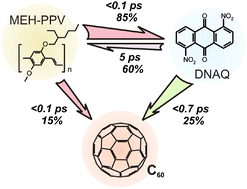Polarization-sensitive time-resolved visible-infrared pump–probe experiments demonstrate that one can efficiently generate long-lived charges in donor–acceptor charge transfer complex (CTC) of conjugated polymer doped with fullerene, MEH-PPV/dinitroanthraquinone/C60. In particular, a strong enhancement of the photoinduced charge generation is observed in the red part of the spectrum, i.e. inside the polymer band gap, which makes the current material attractive for photovoltaic applications. The spectroscopic results indicate that enhanced generation of charges is due to a consecutive photoinduced electron transfer from the polymer to the CTC-acceptor in the first step and then, in the second step, to the fullerene. The LUMO energy difference between the CTC-acceptor and fullerene appears to be a key parameter for efficient charge separation in these ternary systems. The results are also discussed in respect to the charge generation processes in widely used polymer–fullerene blends, where formation of weak CTCs has recently been discovered.

You have access to this article
 Please wait while we load your content...
Something went wrong. Try again?
Please wait while we load your content...
Something went wrong. Try again?


 Please wait while we load your content...
Please wait while we load your content...